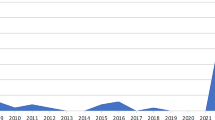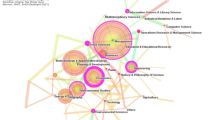Abstract
This study offers a systematic review of academic research on platforms in management, business and economics. By using two visualization tools named VOSviewer and CiteSpace, we analyzed 619 articles on platform research with associated 23,093 references from the Web of Science database. We have discerned the most impact publications, authors, journals, institutions and countries in the platform research. In addition, we have explored the structures of the cited references, cited authors and cited journals to further understand the theoretical basis of the platform research. Moreover, by evolution analysis through CiteSpace and co-occurrence analysis through VOSViewer, we explored the evolution process of platform research and predicted the future development trends. The results conjunctively achieved by VOSviewer and CiteSpace will enhance understanding of platform research and enable future developments for both theorists and practitioners.






Similar content being viewed by others
Notes
eMarketer is a research enterprise that specially provides data, reports and insights in a digital world.
Sina Finance is a Chinese largest financial network media, which focus on in-depth mining industry information and reporting important industrial conferences and events.
References
Geia, L., Pearson, L., & Sweet, M. (2017). Narratives of Twitter as a platform for professional development, innovation, and advocacy. Australian Psychologist, 52(4), 280–287.
Xie, K., Liu, Z., Chen, L., Zhang, W., Liu, S., & Chaudhry, S. S. (2018). Success factors and complex dynamics of crowdfunding: An empirical research on Taobao platform in China. Electronic Markets, 29(2), 187–199.
eMarketer. (2019). US digital video 2019: OTT and mobile video flourish while TV industry undergoes disruption. Retrieved September 19, 2019 from https://www.emarketer.com/content/us-digital-video-2019.
eMarketer. (2019). China digital video 2019: As consumer explore new formats, traditional broadcasters shift strategy. Retrieved September 19, 2019 from https://www.emarketer.com/content/china-digital-video-2019.
eMarketer. (2017). Global ecommerce platforms 2017: A country-by country review of the top retail ecommerce sites. Retrieved July 13, 2017 from https://www.emarketer.com/Report/Global-Ecommerce-Platforms-2017-Country-by-Country-Review-of-Top-Retail-Ecommerce-Sites/2002047.
Sina Finance. (2019). Alibaba’s net profit rose 262% and Softbank gained $2.56 billion. Retrieve November 2, 2019 from http://finance.sina.com.cn/roll/2019-11-02/doc-iicezuev6588699.shtml.
Lin, Z. J. (2014). An empirical investigation of user and system recommendations in e-commerce. Decision Support Systems, 68, 111–124.
Meyer, M. H., & Lehnerd, A. P. (1997). The power of product platforms. New York: The Free Press.
Bresnahan, T. F., & Greenstein, S. (1999). Technological competition and the structure of the computer industry. Journal of Industrial Economics, 47(1), 1–40.
Eisenmann, T., Parker, G., & Van Alstyne, M. W. (2006). Strategies for two-sided markets. Harvard Business Review, 84(10), 92–101.
Boudreau, K. (2010). Open platform strategies and innovation: Granting access vs. devolving control. Management Science, 56(10), 1849–1872.
Gawer, A., & Cusumano, M. A. (2014). Industry platforms and ecosystem innovation. Journal of Product Innovation Management, 31(3), 417–433.
Muffatto, M., & Roveda, M. (2002). Product architecture and platforms: A conceptual framework. International Journal of Technology Management, 24(1), 1–16.
Gawer, A., & Cusumano, M. A. (2002). Platform leadership: How Intel, Microsoft, and Cisco drive industry innovation. Boston: Harvard Business School Press.
Garcia-Swartz, D. D., & Garcia-Vicente, F. (2015). Network effects on the iPhone platform: An empirical examination. Telecommunications Policy, 39(10), 877–895.
Katz, M. L., & Shapiro, C. (1985). Network externalities, competition, and compatibility. The American Economic Review, 75(3), 424–440.
Parker, G. G., & Van Alstyne, M. W. (2005). Two-sided network effects: A theory of information product design. Management Science, 51(10), 1494–1504.
Chen, Yubo, & Xie, Jinhong. (2008). Online consumer review: Word-of-mouth as a new element of marketing communication mix. Management Science, 54(3), 477–491.
Rochet, J. C., & Tirole, J. (2003). Platform competition in two-sided markets. Journal of European Economic Association, 1(4), 990–1029.
Piezunka, H. (2011). Technological platforms: An assessment of the primary types of technological platforms their strategic issues and their linkages to organizational theory. Betriebswirtschaft, 61, 179–226.
Rey-Martí, A., Ribeiro-Soriano, D., & Palacios-Marqués, D. (2016). A bibliometric analysis of social entrepreneurship. Journal Business Research, 69(5), 1651–1655.
Small, H. (1973). Co-citation in the scientific literature: A new measure of the relationship between two documents. Journal of American Society for Information Science, 24(4), 265–269.
Albort-Morant, G., & Ribeiro-Soriano, D. (2016). A bibliometric analysis of international impact of business incubators. Journal of Business Research, 69(5), 1775–1779.
Bellis, N. D. (2009). Bibliometrics and citation analysis: From the science citation index to Cybermetrics. Lanham: Scarecrow Press.
Noyons, E. C., Moed, H. F., & Luwel, M. (1999). Combining mapping and citation analysis for evaluative bibliometric purposes: A bibliometric study. Journal of the American Society for Information Science, 50(2), 115–131.
Thelwall, M. (2008). Bibliometrics to webometrics. Journal of Information Science, 34(4), 605–621.
Cobo, M. J., López-Herrera, A. G., Herrera-Viedma, E., & Herrera, F. (2011). Science mapping software tools: Review, analysis, and cooperative study among tools. Journal of the American Society for Information Science and Technology, 62(7), 1382–1402.
Klavans, R., & Boyack, K. W. (2006). Identifying a better measure of relatedness for mapping science. Journal of the American Society for Information Science and Technology, 57(2), 251–263.
White, H. D., & Mccain, K. W. (1998). Visualizing a discipline: An author co-citation analysis of information science, 1972–1995. Journal of the American Society for Information Science, 49(4), 327–355.
McCain, K. W. (1991). Mapping economics through the journal literature: An experiment in journal co-citation analysis. Journal of the American Society for Information Science, 42(4), 290–296.
Danvila-del-Valle, I., Estévez-Mendoza, C., & Lara, F. J. (2019). Human resources training: A bibliometric analysis. Journal of Business Research, 101, 627–636.
Merigó, J. M., & Yang, J. B. (2017). A bibliometric analysis of operations research and management science. Omega, 73, 37–48.
Carvalho, M. M., Fleury, A., & Lopes, A. P. (2013). An overview of the literature on technology road mapping (TRM): Contributions and trends. Technology, Forecasting & Social Change, 80, 1418–1437.
Gaviria-Marin, M., Merigó, J. M., & Baier-Fuentes, H. (2019). Knowledge management: A global examination based on bibliometric analysis. Technology, Forecasting & Social Change, 140, 194–220.
Robertson, D., & Ulrich, K. (1998). Planning for product platforms. MIT Sloan Management Review, 39(4), 19–31.
Koufteros, X., Vonderembse, M., & Jayaram, J. (2005). Internal and external integration for product development: The contingency effects of uncertainty, equivocality, and platform strategy. Decision Science, 36(1), 97–133.
Asheim, B. T., Boschma, R., & Cooke, P. (2011). Constructing regional advantage: Platform policies based on related variety and differentiated knowledge bases. Regional Studies, 45(7), 893–904.
Dzikowski, P. (2018). A bibliometric analysis of born global firms. Journal of Business Research, 85, 281–294.
Hsu, C. L., Westland, J. C., & Chiang, C. H. (2015). Electronic Commerce Research in seven maps. Electronic Commerce Research, 15(2), 147–158.
Adner, R., & Kapoor, R. (2010). Value creation in innovation ecosystems: How the structure of technological interdependence affects firm performance in new technology generations. Strategic Management Journal, 31(3), 306–333.
Armstrong, M., & Wright, J. (2007). Two-sided markets, competitive bottlenecks and exclusive contracts. Economic Theory, 32(2), 353–380.
Rochet, J. C., & Tirole, J. (2006). Two-sided markets: A progress report. The Rand Journal of Economics, 37(3), 645–667.
Weyl, E. G. (2010). A price theory of multi-sided platforms. American Economic Review, 100(4), 1642–1672.
West, J. (2003). How open is open enough? Melding proprietary and open source platform strategies. Research Policy, 32(7), 1259–1285.
Chesbrough, H., Vanhaverbeke, W., & West, J. (2006). Open innovation: Researching a new paradigm. New York: Oxford University Press on Demand.
Gawer, A. (2011). Platforms, markets and innovation. Cheltenham: Edward Elgar.
Schilling, M. A. (2000). Toward a general modular systems theory and its application to interfirm product modularity. Academy of Management Review, 25(2), 312–334.
Prieger, J. E., & Hu, W. M. (2012). Applications barrier to entry and exclusive vertical contracts in platform markets. Economic Inquiry, 50(2), 435–452.
Schamari, J., & Schaefers, T. (2015). Leaving the home turf: How brands can use webcare on consumer-generated platforms to increase positive consumer engagement. Journal of Interactive Marketing, 30, 20–33.
Maciuliene, M., & Skarzauskiene, A. (2016). Evaluation of of co-creation perspective in networked collaboration platforms. Journal of Business Research, 69(11), 4826–4830.
Cui, Y., Mou, J., & Liu, Y. (2018). Knowledge mapping of social commerce research: A visual analysis using CiteSpace. Electronic Commerce Research, 18(4), 837–868.
Belleflamme, P., Omrani, N., & Peitz, M. (2015). The economics of crowdfunding platforms. Information Economics and Policy, 33, 11–28.
Tiwana, A., Konsynski, B., & Bush, A. A. (2010). Platform evolution: Coevolution of platform architecture, governance, and environmental dynamics. Information Systems Research, 21(4), 675–687.
Meyer, Marc H., & Dhaval, D. (2002). Managing platform architectures and manufacturing processes for nonassembled products. Journal of Product Innovation Management, 19(4), 277–293.
Schilling, M. A. (2015). Technology shocks, technological collaboration, and innovation outcomes. Organization Science, 26(3), 668–686.
Acknowledgements
We would like to thank the editor and the anonymous reviewers for their comments, which assist us to refine our paper. This study is supported by the National Natural Science Foundation of China (Grant Number 71732002—“Research on Organizational Architecture and Collaborative Management of Leading Enterprises’ Innovation Chain”) and by Innovation Enhancement Plan B for Excellent Ph.D. students of Nanjing University (Grant Number 201902B056—“Research on the connotation, characteristics and influence of innovation chain”).
Author information
Authors and Affiliations
Corresponding author
Ethics declarations
Conflict of interest
The authors declare that they have no conflicts of interest.
Additional information
Publisher's Note
Springer Nature remains neutral with regard to jurisdictional claims in published maps and institutional affiliations.
Rights and permissions
About this article
Cite this article
Ding, X., Yang, Z. Knowledge mapping of platform research: a visual analysis using VOSviewer and CiteSpace. Electron Commer Res 22, 787–809 (2022). https://doi.org/10.1007/s10660-020-09410-7
Published:
Issue Date:
DOI: https://doi.org/10.1007/s10660-020-09410-7




